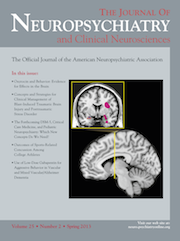Fluctuating Cognitive Deficits and Autonomic Dysfunction: Clarifying the Diagnosis
To the Editor: Lewy-body dementia (LBD) is a relatively common but underdiagnosed neurodegenerative dementia.1 It accounts for 10%–15% of all dementias and is the third most common progressive dementia, after Alzheimer’s disease (AD) and vascular dementia.1,2 LBD is a multisystem disease and typically requires a comprehensive diagnostic approach. Early diagnosis allows for early treatment that may improve quality of life. The principal feature of LBD is progressive cognitive decline, combined with three main defining features: pronounced fluctuations in alertness and attention, recurrent visual hallucinations, and parkinsonian motor symptoms.3 Other features include REM sleep behavior disorder, sensitivity to neuroleptics, repeated falls and syncope, and autonomic dysfunction.3 Symptoms of LBD are caused by the accumulation of alpha-synuclein protein into Lewy bodies inside the nuclei of neurons in the brain areas that control memory and motor functions.2 The similarity of symptoms between LBD and Parkinson’s disease, and between LBD and Alzheimer’s disease; make clinicians focus on differentiating LBD from dementia that occurs over the course of Parkinson’s disease and from AD.4 We report two cases in which symptoms of fluctuating cognition and visual hallucinations, coupled with autonomic dysfunction and syncope, biased clinicians to misdiagnose LBD as delirium.
Case 1
A 76-year-old man who presented with subacute onset of inability to care for himself, memory decline, frequent drowsiness and lethargy, visual hallucinations, repeated falls, and blood pressure fluctuations. His symptoms were pronounced to the point that they could be mistaken for delirium. Myoclonic jerks, rigidity, and tremors were soon noted. CBC, electrolytes panel, thyroid profile, B12, ESR, RPR, Lyme titer, ceruloplasmin, as well as serum protein electrophoresis, ammonia levels, and heavy metal screening were unremarkable. MRI of brain indicated mild-to-moderate, age-appropriate atrophy. Carotid/vertebral artery Dopplet revealed no stenotic abnormalities. EEG showed diffuse slowing. Lumbar puncture was negative. CT of the chest, abdomen, and pelvis showed no acute pathology. On cognitive testing, he exhibited a greater degree of visuoperceptual, visual memory, constructional, and attentional impairment.
Case 2
The patient was a 79-year-old man who was admitted for visual hallucinations, memory impairment, orthostasis, unsteady gait, and fluctuations in cognitive functioning, with varying levels of attention. He also presented with tremors and REM sleep behavior disorder. Delirium was suspected in light of his cognitive fluctuations, autonomic instability, and visual hallucinations. CBC, blood chemistries, thyroid function test, B12 level, and RPR were unremarkable. CT of head indicated mild generalized cerebral atrophy. EEG showed diffuse slowing. Cognitive examination revealed impairment in visual memory, constructional apraxia, poor attention, and executive dysfunction.
Discussion
The patients’ progressive course of cognitive fluctuations, visual hallucinations, and autonomic dysfunction was initially misdiagnosed with delirium. Comprehensive medical work-up was unremarkable. Their memory impairment and functional decline were consistent with diagnosis of dementia. After multiple cognitive assessment and neurology consultation Lewy-body dementia was diagnosed. A person with DLB typically has periods of alertness, coherence, and orientation that alternate with periods of confusion and drowsiness.5 Fluctuations in cognition may last hours or days and have no specific time of day when they can be seen; this is in contrast of the sundowning of AD that tends to occur during the evening.5 On the other hand, the core feature of delirium is disturbance of consciousness. It is reduced clarity of awareness of the environment, with reduced ability to focus, sustain, or shift attention.6 The onset develops within hours-to-days and tends to fluctuate. It is associated with marked short-term memory impairment, disorientation, illusions, delusions, and visual or auditory hallucinations.6 Delirium can usually be traced to its contributing factors, such as a medical illness, medication, surgery, or drug or alcohol abuse. In summary, it is clinically significant to differentiate between delirium and symptoms of LBD in older patients. LBD could be missed if the psychiatrist is not thorough in assessing the patient’s manifestations. Longitudinal course of illness, collateral information from the family, complete medical assessment, and neuropsychiatric evaluation can help clinicians differentiate symptoms of delirium and LBD.
1 : Consensus Guidelines for the Clinical and Pathologic Diagnosis of Dementia With Lewy Bodies (DLB): Report of the Consortium on DLB International Workshop. J Alzheimers Dis 2006; 9(Suppl):417–423Crossref, Medline, Google Scholar
2 :
3 Other dementias and mental disorders due to general medical conditions, in Comprehensive Textbook of Geriatric Psychiatry. Edited by Sadavoy JJ, Grossberg LF, Meyers GT. New York, Norton, pp 545–577Google Scholar
4 : Comparison of dementia with Lewy bodies to Alzheimer’s disease and Parkinson’s disease with dementia. Mov Disord 2004; 19:60–67Crossref, Medline, Google Scholar
5 : Fluctuating cognition in dementia with Lewy bodies and Alzheimer’s disease is qualitatively distinct. J Neurol Neurosurg Psychiatry 2004; 75:382–387Crossref, Medline, Google Scholar
6 Delirium, in Comprehensive Textbook of Geriatric Psychiatry. Sadavoy JJ, Grossberg LF, Meyers GT. New York, Norton, pp 525–554Google Scholar



